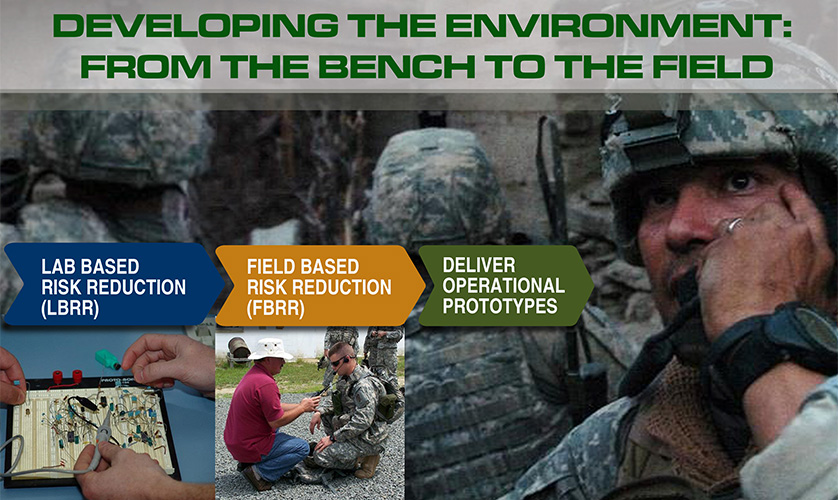
By Kristen Kushiyama, CERDEC Public Affairs
ABERDEEN PROVING GROUND, Md. (February 10, 2016) – An Army research and development representative addressed electronic warfare, cyber and signal intelligence professionals on how the Army is using field experimentation to mature and validate emerging technologies in their field during an event in Wall Township, New Jersey Feb. 10.
The Association of Old Crows’ Garden State Chapter held a lunch-and-learn event for its members to learn about the U.S. Army Communications-Electronics Research, Development and Engineering Center, or CERDEC, revitalization efforts of field experimentation and integration to the Army’s acquisition and operations communities.
Dr. Richard H. Wittstruck, associate director of Field Based Experimentation and Integration for CERDEC’s Space and Terrestrial Directorate, presented CERDEC’s initiatives in field-based risk reduction, which is a process CERDEC uses to demonstrate emerging capabilities to the Army, Joint and Coalition communities and other government organizations as part of transitioning a technology to an operation capability.
“Field-based risk reduction is where engineering meets operations,” Wittstruck said.
Presenting at the luncheon provided Wittstruck the opportunity to address CERDEC’s field-based risk reduction efforts to a relevant audience.
“As we see the convergence of intelligence, cyber and EW capabilities on the battlefield, field-based risk reduction is essential to demonstrating such converged operations concepts to enable unified land operations, and the Association of Old Crows is a forum to discuss and solve these issues,” Wittstruck said.
During the wars in Iraq and Afghanistan, the Army worked on a condensed development and fielding schedule, taking technologies from the labs to the operational field. It did not necessarily follow the Defense Departments analysis for solving Soldier capability gaps known as DOTMLPF-P, which stands for doctrine, organization, training, materiel, leadership, personnel, facilities and policy.
There was some work done in state-side field environments to ensure safety and compatibility but not the full assessment that’s required to characterize and reduce risk of entering operations, Wittstruck said.
“While there was good reason for this shift, a post-conflict transition period with limited resources now mandates a return to our roots,” Wittstruck said. “It’s time for a renaissance to our engineering best practices: modeling and simulation leading to lab-based risk reduction and subsequent field-based risk reduction were the roadmap to successful technology insertion and transition to an operations asset during the 20th century.”
CERDEC has focused its field-based risk reduction efforts into six lines of operation going beyond technology maturation, independent verification, and validation to also include supporting the Assistant Secretary of the Army for Acquisition, Logistics and Technology’s Common Operating Environment, Army initiatives, other government organizations, U.S. Army Reserve and National Guard, Joint military efforts, and the industrial and academic base.
The center has multiple organizations that specifically support the integration of mission command, communications, intelligence, surveillance, reconnaissance and targeting technologies into Army systems and platforms.
The CERDEC Ground Activity at Joint Base McGuire-Dix-Lakehurst in New Jersey focuses on the future network and provides the Army with a relevant assessment venue to mature technology and validate technical progress, and CERDEC space at Fort A.P. Hill and Fort Belvoir both in Virginia have facilities and ranges used to test lasers and sensors safely mine lanes to test hand-held explosive threat detectors, ground penetrating radars and other explosive hazard detection technologies.
CERDEC supports air platforms through the CERDEC Flight Activity at JB MDL, which provides end-to-end aviation support for these emerging technologies, quick reaction capabilities to units and post-production aircraft modifications for program executive offices and project managers, and its Aviation Research and Development Sensors Test and Evaluation Facility at Fort Belvoir that is used during the development of both pilotage and target acquisition systems for current and future Army aircraft.
“High-visibility Army efforts such as converged command post, transport convergence, multi-function teams and tactical cyber demand a robust field-based risk reduction process to demonstrate these future Army operations concepts in a tactically relevant framework for Army, Joint and coalition interoperability,” Wittstruck said. “As the Army restructures its forces and capabilities, field-based risk reduction provides an experimentation and integration environment to reduce risk and inform Army investment decisions.”









